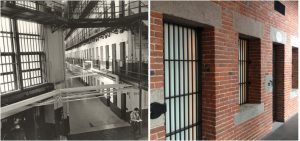
July 20, 2017 Summer Staycation: Boston’s Historic Hotels
Boston’s historic hotels serve as incredible looking glasses into the past and not only showcase different architectural styles, but demonstrate how historic preservation can transform a building.
In addition to the abundance of history here, Boston is home to many historic hotels as recognized by the National Trust for Historic Preservation’s Historic Hotels of America and  some of which were important backdrops to the city’s history, places like the elegant Oval Room at the Fairmont Copley Plaza or Boston’s first skyscraper, the Ames Building, now housing the Ames Boston Hotel, or the Marriott Vacation Club that now fills the narrow stretch of the 1916 Custom House. In 1928, the Batterymarch Building, designed by architect Harold Field Kellogg, became Boston’s first Art Deco style skyscraper. Those architectural elements are visible today in the two story brick arch, detailed in terra cotta that forms the entryway of what is now the Hilton Faneuil Hall. Perhaps the most historic Boston hotel is the Omni Parker House, which also serves as the longest continuously operating hotel in the United States. The Omni Parker House, located on the Freedom Trail just steps away from the Old Corner Bookstore, has hosted every US President since Ulysses S. Grant. In particular one former President, John F. Kennedy, is very connected to the hotel. It was here where JFK first announced his candidacy for Senate and proposed to Jackie Kennedy. The famous Boston cream pie and Parker House rolls were also created inside the historic Omni Parker House, and both Malcolm X and Ho Chi Mihn worked at the hotel when they lived in Boston.
some of which were important backdrops to the city’s history, places like the elegant Oval Room at the Fairmont Copley Plaza or Boston’s first skyscraper, the Ames Building, now housing the Ames Boston Hotel, or the Marriott Vacation Club that now fills the narrow stretch of the 1916 Custom House. In 1928, the Batterymarch Building, designed by architect Harold Field Kellogg, became Boston’s first Art Deco style skyscraper. Those architectural elements are visible today in the two story brick arch, detailed in terra cotta that forms the entryway of what is now the Hilton Faneuil Hall. Perhaps the most historic Boston hotel is the Omni Parker House, which also serves as the longest continuously operating hotel in the United States. The Omni Parker House, located on the Freedom Trail just steps away from the Old Corner Bookstore, has hosted every US President since Ulysses S. Grant. In particular one former President, John F. Kennedy, is very connected to the hotel. It was here where JFK first announced his candidacy for Senate and proposed to Jackie Kennedy. The famous Boston cream pie and Parker House rolls were also created inside the historic Omni Parker House, and both Malcolm X and Ho Chi Mihn worked at the hotel when they lived in Boston.
While many of the historic hotels in Boston were built to serve as hotels, The Liberty Hotel, is an exciting example of creative rehabilitation of an historic building for a new use. The Suffolk County (Charles Street) jail, designed by J. Gridley Bryant, was built in 1851 and served as a jail until 1990. The building sat vacant at the base of Beacon Hill, until developer Dick Friedman and architects at Cambridge 7 Associates, undertook the building’s $150 million restoration and opened the hotel in 2007. The careful restoration was done to thoughtfully preserve the famed rotunda, Quincy granite exterior, cell doors, and wrought iron catwalk railings.
Historic hotels offer rich insight into the architecture and preservation of a city. The growing trend of heritage tourism supports a high demand for older hotels with character and history, and the transformation of historic buildings for new hotels. Boston?s historic hotels are a prime example of how preservation can renew and adaptively reuse a building and there are many more in this city and region. What are some of your favorites?



